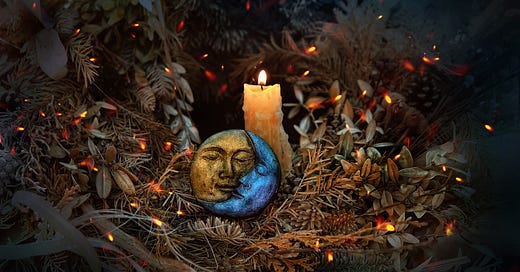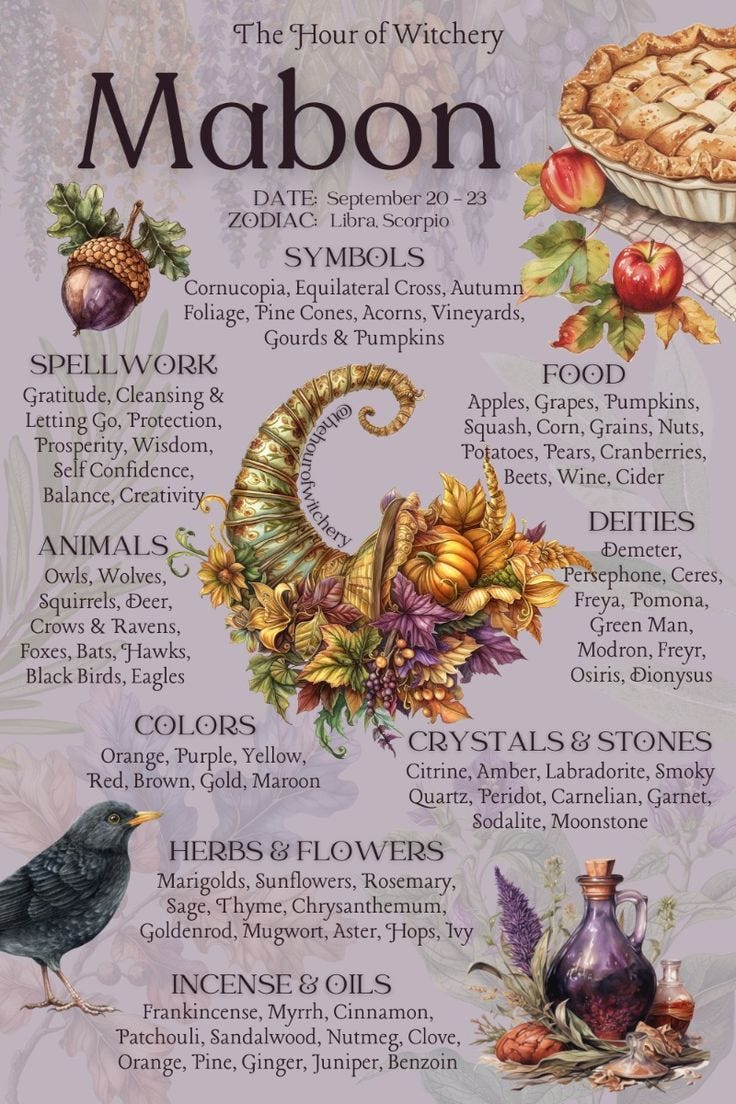Mabon Challenge Day 4: A Nourishing Mabon Celebration Guide
It's Mabon, y'all!
Hello! To receive the posts in this series in your email, please head to inkroads.substack.com/account and toggle your Eco-Arts Sanctuary tab on. In order to access the full posts, please consider becoming a paid subscriber. As always, thanks for being here.
*
Hi everyone and happy Mabon!
It’s officially the autumn equinox. We stand at the juncture between light and darkness, at the pinprick where the dying light of summer casts its last glimmers onto the autumnal shadows that stretch their hands towards us, calling us to them.
But the darkness of autumn does not mean sorrow; quite the contrary.
This season invites us to slow down, pull what we love close, and light our candles and bonfires and inner furnaces. If summer is a time of sun and expansion and fire, autumn is for the rise of the dark goddess, the shadow walker, the bone-witch, and the time-dancer. This is the moment for the one who walks between the worlds.
The changing of the seasons is an alchemical time. Now the leaves are beginning to change color, starting to wither and die so they can turn back into soil that nourishes the roots of the trees that grew them in the first place. Slight chills slip down from the north, tainting the hot wind, soothing our sweaty brows.
We all feel it in our own ways. Doesn’t this particular seasonal change have a specific flavor, a unique tone? For many people, this seasonal shift means it’s simply time to pull out our sweaters, Halloween decorations, and pumpkin spice lattes — but doesn’t even that show that we still know that we must warm ourselves up, pull our loved ones close, and begin to dance with the spirits and hauntings and longings that emerge during this time?
Anyways, all that is a long way of saying: happy autumn, all. And thank you for being here. I hope the past few days have helped you gently thank and release the summer.
Now we will celebrate this sacred transition, make offerings to the spirits and energies of this shift, and call in what we want to see in this new season.
*
As I mentioned in my first email, Mabon takes its name from the tale of the god Mabon, who was stolen from his mother as a young child. It’s also inspired by Persephone’s story, and falls around the time of the Eleusinian Mysteries, the ancient festival that honored her descent into the underworld — which of course is inextricable from her subsequent rise.
This all means that Mabon is, in its way, about grief, which makes perfect sense when you look at the seasonal changes that are taking place during this juncture. Mabon falls at a time of year when crops are beginning to die, a time when people were traditionally faced with a long winter ahead before the land would again start to provide for them.
But Mabon is also a time of joy in the form of gratitude and faith in resurrection. In the Welsh story, Mabon was eventually found after years imprisoned in a cave. He ultimately went free, wandering the world as a hunter.
Persephone, meanwhile, does rise again, every single spring — and her fate in Hades may not be entirely tragic in itself. There are many interpretations of what happened to her down there, but I prefer to embrace the idea that she wanted to become the Queen of the Dead, or at least came to relish her role in the icy deeps.
I believe Persephone’s story teaches us that as we embrace our shadows and the shadowier times of the year, we find new realms of power, depth, and alchemical transformation. This may be the fundamental lesson of Mabon and autumn itself.
That is not to say we should eliminate emotion from the equation or disregard the fact that embracing the shadow and the fall can mean suffering. Embracing the fall means embracing endings, too, as they clear space for the new.
As the leaves wither and turn gold, Mabon asks us to move towards our next chapters. This is a time of balance and cyclicality. Release and gratitude. A time of duality. A time of light and darkness in equal measure. I hope you use it as a way to honor the beauty of your inner duality, which really is not duality at all but rather is wholeness when viewed through a lens of broad, compassionate acceptance.
So this Mabon, honor your wildness and your peace. Your love and your rage. Your energy and your exhaustion. Your sadness and your joy. Hold yourself in the fullness of your entire being.
Mabon reminds us that in our duality, our contradictoriness, and ever-changing wildness, we are enough as we are.
How to Celebrate Mabon
Keep reading with a 7-day free trial
Subscribe to Ink Roads to keep reading this post and get 7 days of free access to the full post archives.





